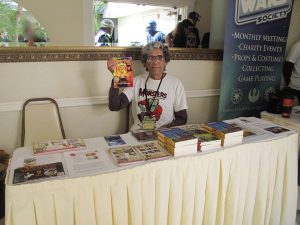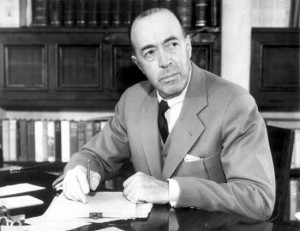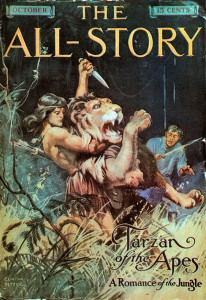
David Lemmo
Author David Lemmo and I go way back to the early nineties, when he became one of the first writers to join a read & critique workshop that I facilitated in my home. David enjoyed reading—and writing—the same genres as I did and, given both his writing abilities and his offbeat personality, we really hit it off. He has always been a huge fan of my own personal muse, Edgar Rice Burroughs, so it pleased me no end to see his non-fiction book, Tarzan, Jungle King of Popular Culture, published earlier this year. Here are some thoughts from David about ERB and his most famous creation.
The Ape-Man of writer Edgar Rice Burroughs’ incredible imagination first appeared over a century ago when advances in science and a growing population were merging to create what eventually became the super-media of the 21st century. Springing into life in 1912, this foster son of a she-ape became both the first multimedia superstar, and the first seminal super-hero to emerge from the twentieth century.
 Burroughs, considered the “grandfather of American science fiction,” was the son of a stern American Civil War veteran (The Major) and a loving, adventurous mother. ERB was born in Chicago on September 1, 1875. He grew up at a time when new forms of science and technology were appearing, creating a second scientific revolution based on electricity and oil. This revolution, especially in communications, and the great numbers of people immigrating to the U.S., slowly created a cultural need for the mass marketing of items and, what is also important, a mass media. This mass media would become an integral part of the American Dream.
Burroughs, considered the “grandfather of American science fiction,” was the son of a stern American Civil War veteran (The Major) and a loving, adventurous mother. ERB was born in Chicago on September 1, 1875. He grew up at a time when new forms of science and technology were appearing, creating a second scientific revolution based on electricity and oil. This revolution, especially in communications, and the great numbers of people immigrating to the U.S., slowly created a cultural need for the mass marketing of items and, what is also important, a mass media. This mass media would become an integral part of the American Dream.
ERB had been a cowboy, military academy cadet, a cavalry soldier, and a gold miner. Rejected as a candidate for West Point, he was also discharged early from the cavalry because of a weak heart. ERB worked at a series of dead-end jobs that barely made living expenses. He was dependent on his father, The Major, who dictated his course of life, and continually got him out of financial trouble.

Edgar Rice Burroughs
At the age of thirty-five ERB, possessed of an above-average education and an incredible imagination, published his first story, Under the Moons of Mars. This science fiction tale, with its hero, John Carter, was serialized in six parts beginning with the February 1912 issue of All-Story magazine.
Despite this success, his real job still wasn’t making living expenses. His second story, The Outlaw of Torn, a 13th century English swashbuckler, was rejected by All-Story editor Thomas Newell Metcalf. This editor suggested that ERB try another of the “improbable variety of tale.”
By this time ERB’s creative fire had stepped up to the plate, leaving him determined to knock it out of the ballpark. He wrote to Metcalf, saying, “I have been working at odd moments on another of the improbable variety of tale…” ERB wrote his story during the evenings, on what he described as “odd pieces of paper.”
Again, his creative imagination emerged in ways not in keeping with his life experiences. He frequently said that the ancient myth of Romulus and Remus, raised by wolves, first inspired him. He thought that his story “…would not sell.” ERB’s latest creation, titled Tarzan of the Apes, was bought enthusiastically for All-Story magazine.
 My book, Tarzan, Jungle King of Popular Culture, is also for people who are not especially Tarzan fans. It’s about popular culture, fandom, what I call a continuity of popular culture, controversies connected to the character, and the evolution of the superhero concept. This book could have been about Superman, Batman, or Wonder Woman. But besides being a Tarzan fan, I feel you get something for being both the first multimedia superstar, and the first seminal superhero of the 20th century.
My book, Tarzan, Jungle King of Popular Culture, is also for people who are not especially Tarzan fans. It’s about popular culture, fandom, what I call a continuity of popular culture, controversies connected to the character, and the evolution of the superhero concept. This book could have been about Superman, Batman, or Wonder Woman. But besides being a Tarzan fan, I feel you get something for being both the first multimedia superstar, and the first seminal superhero of the 20th century.
I trace the superhero evolution following Tarzan, Zorro, Charlie Chan, The Shadow, The Lone Ranger and Tonto, Doc Savage, and the Phantom (Ghost who walks). These eight extraordinary characters, in my view, are the foundations of the superhero concept. The next group following the eight extrapolated on them. Superman, Batman, Wonder Woman, The Flash, etc., joined them in an explosion of popular culture through their comic book adventures.
David Lemmo’s book, Tarzan, Jungle King of Popular Culture, published by McFarland & Company, is available from most places where you buy books. Here is the Amazon link.
For more about Edgar Rice Burroughs see my posts, “Thank You, Edgar Rice Burroughs,” and “Edgar Rice Burroughs: The Master Of Lost Worlds.”
